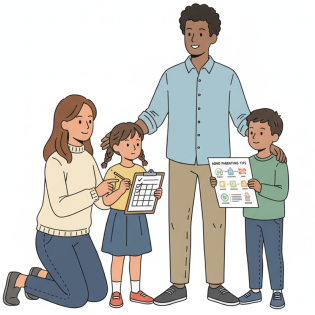
Understanding Vanderbilt ADHD Parent Scoring Methods
Families often face uncertainty when attention challenges disrupt daily routines, schoolwork, and peer relationships. Within that structure, Vanderbilt ADHD parent scoring provides a consistent method for translating observations into numbers. By turning behaviors into clearly defined ratings, caregivers and clinicians can discuss patterns with a shared vocabulary. The approach reduces guesswork, aligns expectations, and highlights where support is most urgently needed. As a result, coordinated planning becomes more efficient and more compassionate.
What Parents Should Know
Parents frequently ask how to separate normal distractibility from clinically meaningful symptoms. In many clinics, the Vanderbilt ADHD parent rating scale is used as an evidence-based screening instrument that frames this distinction thoughtfully. It organizes behaviors by domains, helping adults see whether concerns reflect inattention, hyperactivity, or broader mood and conduct areas. That clarity anchors early decision-making and speeds referrals when further evaluation is appropriate.

ADHD Parenting Essentials: Scoring and Thresholds
Understanding how the instrument groups behaviors is the key to accurate interpretation and calm decision-making. For context and further learning, many families supplement their knowledge with ADHD resources parents trust, including clinic handouts and reputable clinical organizations. The checklist aggregates symptom ratings, flags threshold patterns, and pairs them with performance indicators such as schoolwork, relationships, and organization. This dual focus helps distinguish frequency of symptoms from real-world impact.
| Domain | Number of Items | Symptom Threshold | Performance Indicators |
|---|---|---|---|
| Inattention | 9 | 6+ items often/very often | Academic work completion, organization, following instructions |
| Hyperactivity/Impulsivity | 9 | 6+ items often/very often | Restlessness, waiting turn, interrupting, activity level |
| Oppositional/Conduct | 10 | Pattern of elevated items | Compliance, rule-following, conflict with adults/peers |
| Anxiety/Depression | 7 | Pattern of elevated items | Worry, sadness, irritability, sleep and appetite changes |
| Performance | 8 | Functional impairment noted | School performance, peer relations, family life, activities |
Clinicians appreciate that the scoring maps directly to clinical decision points without overwhelming jargon. In comprehensive assessments, the Vanderbilt ADHD diagnostic parent rating scale is paired with teacher input and clinical interviews to guard against bias or situational effects. Multi-informant data allows patterns to emerge across home and school, strengthening confidence in any conclusions. This triangulation is essential for responsible screening. Parents also want to know which scores matter most and what to do next. After reviewing results, many providers surface concrete strategies and connect families to ADHD help parents programs that target organization, routines, and supportive communication. The emphasis is on practical changes that families can sustain, with follow-up monitoring to track progress. Small, consistent adjustments tend to compound into meaningful gains.
Simple Scoring, Better Care
Caregivers benefit from tools that are structured yet understandable. In comparative terms, the ADHD parent rating scale stands out for its practicality, length, and straightforward scoring anchored to observable behaviors. The instrument’s wording emphasizes real-life examples, making it easier to rate consistently across different days. When caregivers feel confident in the process, they provide better data, and that leads to better care.

- 1Look for consistency across raters and across settings to validate patterns.
- 2Map the highest-frequency items to the toughest daily moments for targeted planning.
- 3Identify strengths that can be leveraged to offset vulnerabilities.
- 4Use performance items to prioritize goals in academics and relationships.
ADHD Tips for Parents: from Assessment to Routines
Numbers are most powerful when they spark collaborative planning between caregivers, schools, and clinicians. In this context, ADHD parenting becomes a guided practice grounded in consistent routines and clear expectations. Instead of focusing only on symptom counts, interpretation should balance patterns with day-to-day functioning. When ratings and lived experience align, intervention choices feel intuitive and motivating.

Behavioral supports often become more effective when they are precise and measured. In many care plans, structured coaching and evidence-based curricula integrate elements similar to parent training ADHD programs delivered in small groups or one-on-one. These approaches translate assessment data into stepwise strategies such as visual schedules, reinforcement systems, and transition planning. With regular check-ins, teams can adapt quickly to what works. Caregivers usually thrive when they understand the rationale behind each step. Many introductory overviews emphasize core principles aligned with ADHD what every parent needs to know so families can advocate confidently at school and in clinics. When adults grasp why a strategy helps a specific behavior, follow-through improves and stress declines. Knowledge empowers persistence during challenging weeks.
- 1Define one or two high-impact goals per week and review them on a set day.
- 2Use brief, labeled praise to reinforce desired behaviors immediately.
- 3Break tasks into tiny steps and add movement breaks between segments.
- 4Coordinate with teachers to align expectations and feedback systems.
ADHD Planning for Families
Successful support blends clarity, compassion, and consistency across environments. Early in the process, clinicians often recommend completing a structured ADHD parent questionnaire and collecting teacher input to capture classroom realities. With that foundation, families can draft a simple action plan and coordinate with educators about accommodations. Written agreements reduce confusion and speed up implementation.

Using the ADHD Parent Questionnaire for Routines
Progress accelerates when goals are specific and small wins are celebrated. Many caregivers find that checklists and timers pair well with routines inspired by ADHD tips for parents offered by therapists and school psychologists. Visual cues at home, plus predictable transitions, reduce friction and support autonomy. As skills grow, supports can be gradually faded. Positive momentum requires ongoing tracking and gentle adjustments. Families frequently combine calendars, micro-rewards, and task chunking with insights drawn from ADHD parenting tips they have tested over time. Data doesn’t need to be complicated; quick notes on routines, sleep, and homework can reveal patterns. When setbacks occur, teams iterate rather than abandon the plan.

Resources, Training, and Support Over Time
Long-term success depends on community, credible information, and accessible professionals. Peer networks help normalize the journey for caregivers who might otherwise feel isolated, including many ADHD parents seeking shared strategies and encouragement. Local clinics, school-based teams, and nonprofit organizations can connect families to groups, workshops, and coaching. The result is a support ecosystem rather than a single appointment. Structured materials keep everyone aligned when life becomes chaotic. Many clinics provide a concise handbook functioning as an ADHD parent guide, with checklists, sample routines, and troubleshooting tips organized by age. Digital versions make it easy to share with teachers and relatives who help with homework or after-school activities. Standardized language streamlines communication and reduces mixed messages.
- 1Evidence-based parent coaching programs with session-by-session skills.
- 2School collaboration templates for progress notes and goal reviews.
- 3Mobile tools for task sequencing, reminders, and reward tracking.
- 4Community groups moderated by trained facilitators for accountability.
ADHD Guide for Parents: Adjusting to New Challenges
Sustained improvement is typically the product of incremental refinements guided by data and empathy. Families often return to a well-curated manual that functions as an ADHD guide for parents, updating strategies as children mature and academic demands shift. With periodic reassessment, teams can spot new challenges early and adjust supports. This steady, iterative approach builds resilience and confidence.
Frequently Asked Questions
- Is the Vanderbilt tool a diagnostic test?
No, it is a validated screening and monitoring instrument that informs, but does not replace, a full clinical evaluation. Clinicians interpret results alongside interviews, developmental history, school reports, and sometimes additional measures. The combined picture guides diagnosis and treatment planning.
- Who should complete the forms?
Ideally, at least one primary caregiver and one teacher complete their respective forms to capture behavior across settings. Additional adults who observe the child regularly, such as coaches or after-care providers, can offer valuable context. Multiple perspectives enhance accuracy.
- How often should scoring be repeated?
Reassessment is useful at baseline, after starting an intervention, and during follow-ups to gauge change over time. Many teams choose intervals of 6–12 weeks depending on the intensity of supports. Consistent timing helps compare results meaningfully.
- What if home and school ratings disagree?
Differences are common because environments place distinct demands on attention, organization, and impulse control. Clinicians look for patterns, triggers, and accommodations that might explain the variance. Action plans can then be tailored to each context.
- How are performance items used in planning?
Performance ratings translate symptom patterns into day-to-day priorities for learning and relationships. Teams select a small number of goals, define concrete strategies, and monitor progress with brief notes. Adjustments are made based on what demonstrably improves functioning.
The Latest News
-
![Comprehensive Guide to the Parent-Based ADHD Rating Process]()
- 4 November, 2025
-
![A Complete Guide to the Vanderbilt Parent Rating for ADHD]()
- 3 November, 2025
-
![Parent-Rated ADHD Screening: A Comprehensive, Practical, and Trustworthy Guide]()
- 31 October, 2025
Please Note
This website (vanderbiltadhdparentscoring.com) is not an official representative, creator or developer of this application, or product. All the copyrighted materials belong to their respective owners. All the content on this website is used for educational and informative purposes only.



